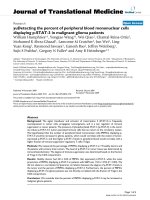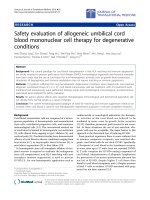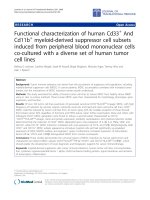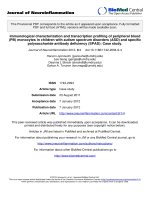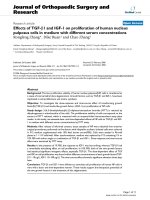Soluble mediator profiles of cord blood mononuclear cells in early onset childhood allergic disorders
Bạn đang xem bản rút gọn của tài liệu. Xem và tải ngay bản đầy đủ của tài liệu tại đây (6.96 MB, 267 trang )
SOLUBLE MEDIATOR PROFILES OF CORD BLOOD MONONUCLEAR
CELLS IN EARLY ONSET CHILDHOOD ALLERGIC DISORDERS
QUAH PHAIK LING
B.Sc. (Biotech) (Hons.), Monash
A THESIS SUBMITTED FOR THE DEGREE OF DOCTOR OF PHILOSOPHY
DEPARTMENT OF PAEDIATRICS
NATIONAL UNIVERSITY OF SINGAPORE
2013
i
DECLARATION
I hereby declare that this thesis is my original work and it has been written by me in
its entirety. I have duly acknowledged all the sources of information which have been
used in the thesis.
This thesis has also not been submitted for any degree in any university previously.
______________________________________
Quah Phaik Ling
21 January 2013
ii
ACKNOWLEDGMENTS
Completing a PhD is truly a marathon event, and I would not have been able to
complete this journey without the aid and support of countless people over the past six
years.
Firstly, I am very fortunate to have not only one but three remarkable supervisors. It is
difficult to overstate my gratitude to my PhD supervisor, the late Professor Chua Kaw
Yan whom I was fortunate enough to have as an advisor. Thank you for always
believing in me, this project, for giving me the opportunity to pursue my PhD as a
part-time student in NUS, and last but not least for setting the direction and focus for
my research. I am also very much indebted to my supervisor Professor Lee Bee Wah
whose enthusiasm, inspiration, dedication and constructive criticism has allowed me
to challenge myself to achieve something greater than what I thought I was capable
of. To Dr Kuo I-Chun, I thank you for supporting me throughout my thesis-writing
period, for reviewing my manuscripts, providing me encouragement, sound advice,
good teaching, good company, and lots of good ideas.
I thank the Principal Investigator of this study, A/Prof Lynette Shek for trusting me
with the cord blood samples that has been collected for the PROMPT study which
made this dissertation possible.
I am grateful to the members of the PhD Qualifying Examination panel, Professor
Hugo van Bever, Professor Koh Dow Rhoon, for their critical suggestions and advice.
I wish to thank biostatisticians Dr. Chan Yiong Huak and Dr. Shen Liang for the
providing me with statistical advice at times of critical need.
A big thank you goes out to the PROMPT (PRObiotic in Milk for the Prevention of
aTopy trial) team – Corinne Kwek Poh Lian, Dr. Genevieve Llanora, Dr. Irvin Gerez
and Bautista Fatima Yturriaga who assisted in the follow-up data of the subjects, and
on top of that every one of you made hanging out in the Porta Cabin and compiling
data a lot more fun.
A special thank you goes out to all the occupants in the asthma and allergy laboratory,
and to the wonderful people that I have spent the past 6 years with in the Clinical
Research Center of NUS. I feel truly blessed to say that we are all more than just
working colleagues, we are friends. You have filled my years here with so much
laughter and joy and never ending encouragement, I wouldn’t have made it till the end
without each and every one of you.
Last but not least, I would also like to thank my family for the relentless support they
provided me through my entire life and in particular, I must acknowledge my husband
and best friend, Justin, without whose love, encouragement and patience, I would not
have finished this dissertation.
In conclusion, I recognize that this research would not have been possible without the
financial assistance of the National Medical Research Council, Singapore (NMRC
/0674/2002).
iii
iv
TABLE OF CONTENTS
Summary xi
List of tables xiv
List of figures xiv
List of abbreviations xix
Chapter 1: Introduction and literature review
1.1 Introduction 1
1.2 Atopy and allergic disorders. 2
1.2.1 Definitions 2
1.2.1.1 Atopy 2
1.2.1.2 Eczema 3
1.2.1.3 Asthma and wheeze 4
1.2.1.4 Rhinitis 6
1.2.2 The atopic march. 7
1.2.2.1 Birth cohort studies 7
1.2.2.2 Role of atopy 8
1.2.3 Prenatal influence on atopic disorders 10
1.3 Innate immunity 12
1.3.1 Toll-Like-Receptors 13
1.3.1.1 Bridging the innate and adaptive immunity with Toll-Like-Receptors 14
1.4 Cord blood mononuclear cells (CBMCs) responses and atopic disorders 15
1.4.1 Fetal responses to allergens 16
1.4.2 CBMC proliferative responses and atopic disorders. 16
1.4.3 Cord blood IgE in allergic disorders. 18
1.4.4 Cord blood mononuclear cell (CBMC) cytokine responses. 19
1.4.4.1 Network of cytokines determines CD4
+
T-cell fates 19
v
1.4.4.2 Cord blood mononuclear cell (CBMCs) cytokine profiles in infants at
risk for atopy 22
1.4.4.3 Cord blood mononuclear cell (CBMC) cytokine profiles at birth and
subsequent allergic disorders 24
1.4.4.4 Inconsistencies in cord blood studies and Th1/Th2 cytokines 28
1.5 Chemokines in the role of allergic disorders 32
1.5.1 Chemokines in innate immunity 32
1.5.2 Chemokines in the pathogenesis of eczema 32
1.5.3 Chemokines in the pathogenesis of asthma 33
1.5.4 Chemokines and other soluble mediators in the role of allergic disorders 33
1.6 Rationale of study 36
1.7 Study hypothesis and aims of study. 39
Chapter 2: Materials and methods
2.1 Subject recruitment and cord blood collection 42
2.2 Details of inclusion/exclusion criteria 42
2.2.1 Inclusion criteria 42
2.2.1.1 Pre-delivery evaluation 42
2.2.1.2 Post-delivery evaluation 43
2.2.2 Exclusion criteria. 43
2.3 Background on study 43
2.4 Processing and storage of cord blood mononuclear cells from cord blood
samples collected 44
2.5 Clinical assessment 45
2.6 Skin prick test and serum collection. 46
2.6.1 Skin prick test 46
2.6.2 Serum collection and IgE measurement 47
2.7 Selecting cord blood samples for further studies 47
vi
Chapter 3: Development of allergic phenotypes from at risk for atopy
Singapore cohort in a five year follow-up study- Early life risk factors
and progression of allergic phenotypes
3.1 Introduction 48
3.2 Methods 49
3.2.1 Subject recruitment, clinical assessment and skin prick test 49
3.2.2 Statistical analysis. 49
3.3 Results 52
3.3.1 Demographic data of the allergic phenotypes at 5 years of age 52
3.3.2 Manifestations of allergic disorders up to 5 years of age 56
3.3.3 Co-existent of allergic phenotypes at year 5 58
3.3.4 Phenotypes of eczema and wheeze 58
3.3.5 Allergic disorders and allergen sensitization 61
3.3.6 Association of allergen sensitization to allergic phenotypes at 2 and 5
years of age 63
3.3.7 Progression of early allergic phenotypes up to 5 years of age 66
3.3.7.1 Progression of early allergic phenotypes 66
3.3.7.2 Association of risk factors at 2 years and clinical phenotype outcomes
at 5 years 68
3.4 Discussion 70
Chapter 4: Optimizing in vitro cell culture experiments with cord blood
mononuclear cells in serum-free medium
4.1 Introduction 76
4.2 Materials and methods 78
4.2.1 Preparation and storage of cord blood mononuclear cells (CBMCs) and
peripheral blood mononuclear cells (PBMC) 78
4.2.2 Stimulation of cord blood cells with lipopolysaccharide (LPS) and
phytohaemagglutinin (PHA) for dosage and kinetic studies 78
vii
4.2.3 Cytokine protein detection 79
4.2.3.1 Fluorescence activated cell sorter (FACS) –Array (Becton Dickinson) 79
4.2.4 Comparison of cell culture conditions 80
4.2.4.1 Cell culture of CBMC in serum-free AIM-V medium 80
4.2.4.2 Cell culture of CBMC in RPMI media supplemented with fetal calf
serum (FCS) 80
4.2.4.3 Cell culture of CBMC with the recombinant IFN-γ ( rIFN-γ) priming 81
4.2.5 Polymyxin B and TLR4 blocking experiment 81
4.2.6 Statistical analysis 82
4.3 Results 82
4.3.1 Lipopolysaccharide (LPS) stimulated CBMC cytokine response in
serum free AIM-V medium compared to RPMI-serum supplemented media 82
4.3.2 Kinetic and dosage response of lipopolysaccharide (LPS) stimulated
cytokine production from cord blood mononuclear cells in the serum-free
AIM-V medium 85
4.3.3 Kinetics and dosage responses of phytohaemagglutinin (PHA)
stimulated cytokine production from cord blood mononuclear cells in the
serum-free AIM-V medium 87
4.3.4 Comparison of cytokine secretion profiles between cord blood
mononuclear cells (CBMCs) and peripheral blood mononuclear cells
(PBMCs) in the AIM-V serum free medium 89
4.3.5 Inhibition of lipopolysaccharide (LPS) stimulated cytokine production
by polymyxin B and anti-TLR4 antibody 91
4.4 Discussion 93
Chapter 5: Cytokine profiles of lipopolysaccharide (LPS) and
phytohaemagglutinin (PHA) stimulated cord blood mononuclear cells
(CBMCs) and their correlation with clinical outcomes in the first 5 years
of life
5.1 Introduction 97
5.2 Materials and methods 98
5.2.1 Subject recruitment criteria 98
5.2.2 Follow up examination 99
viii
5.2.3 Cord blood collection and clinical outcome assessment 99
5.2.4 Subjects selected for cord blood responses 102
5.2.5 Preparation of cord blood mononuclear cells (CBMCs) 103
5.2.6 Stimulation of cord blood cells with lipopolysaccharide (LPS) and
phytohaemaglutinin (PHA) 103
5.2.7 Cytokine protein detection by the Fluorescence activated cell sorter
(FACS)–Array (Becton Dickinson) 104
5.2.8 Cytokines measured from cord blood mononuclear cells (CBMCs) and
clinical phenotypes of interest 104
5.2.9 Intracellular staining and flow cytometry 106
5.2.10 Statistical analysis 107
5.3Results 110
5.3.1 Cytokine responses in lipopolysaccharide (LPS) and
phytohaemagglutinin (PHA) - stimulated cord blood mononuclear cells
(CBMCs) assessed in relation to the clinical outcomes of eczema and wheeze
at 2 years of age 110
5.3.1.2 LPS and PHA stimulated IL-6, IL-8 and TNF-α 110
5.3.1.3 LPS stimulated IL-12/IL-23p40 and IL-1β 111
5.3.1.4 LPS and PHA stimulated cytokine IL-10 114
5.3.1.5 PHA stimulated T-cell cytokines IL-5, IL-2, IL-3 and IFN γ 114
5.3.2 Cytokine profiles of subjects who are healthy with allergen sensitization
at 2 years of age 116
5.3.3 Logistic regression analysis of LPS and PHA stimulated CBMC
cytokine profiles of eczema and wheeze subjects 120
5.3.3.1 Logistic regression adjusting for factors confounding cytokine
profiles 120
5.3.3.2 Logistic regression to determine main risk factors 120
5.3.4 Factor Analysis of cytokine profiles 124
5.3.4.1 Factor analysis of LPS stimulated cytokine profiles 124
5.3.4.2 Factor analysis on PHA stimulated cytokine profile 127
5.3.5 Monocytes are main producers for LPS stimulated IL-6 and both LPS
and PHA IL-8 in LPS stimulated CBMCs 128
ix
5.3.6 Association of LPS and PHA stimulated cytokine profiles with eczema
and wheeze outcomes at 5 years of age 131
5.4 Discussion 136
Chapter 6: Chemokine and other soluble mediator profiles in association
to eczema, wheeze and allergen sensitization
6.1Introduction 145
6.2 Materials and methods 146
6.2.1 Subject selected for study 146
6.2.2 Multiplex assays 147
6.2.2.1 Selection of soluble mediators of interest using the RayBio cytokine
antibody array 147
6.2.2.2 Quantification of soluble mediators 148
6.2.3 Statistical analysis 149
6.3 Results 149
6.3.1 Association of cord blood mononuclear cell (CBMC) production of
chemokines, cytokines, soluble receptors, MMP-TIMP and growth factors in
relation to allergen sensitization, eczema and wheeze at 2 years of age 149
6.3.1.1 Allergen sensitization profile at 2 years of age 150
6.3.1.2 Eczema and wheeze profile at 2 years of age 155
6.3.1.3 Logistic regression of eczema, wheeze and allergen sensitization
profiles 161
6.3.2 Association of cord blood mononuclear cell (CBMC) production of
chemokines, cytokines, soluble receptors, MMP-TIMP and growth factors in
relation to later eczema, wheeze or allergen sensitization at 5 years of age 162
6.4Discussion 167
6.4.1 Allergen sensitization 167
6.4.2 Eczema 171
6.4.3 Wheeze 174
Chapter 7: Conclusions and Future Directions 177
x
Bibliography 183
Appendix A 209
Appendix B 214
Appendix C 229
Appendix D 230
Appendix E 231
Appendix F 234
Appendix G 235
Appendix H 240
Appendix I 242
Appendix J 244
Publication
xi
SUMMARY
Background
Neonates with a family history of atopy are at higher risk for developing allergic
disorders in early life. The inherent immunological responses at birth are emerging as
an important participant in allergic disorders.
Objectives
This dissertation aims to:
i) study the early life demographic and clinical risk factors and the
progression of allergic phenotypes in a 5 year follow-up from a birth
cohort of high risk ( first degree relative with allergic disorder and allergen
sensitization) for atopy infants.
ii) evaluate the influence of intrinsic immunologic responses in cord blood
mononuclear cells on eczema and wheezing disorders and allergen
sensitization at 2 years and 5 years of age.
Methods
This study is centered in a cohort of 253 newborn infants who participated in a
double-blind, placebo-controlled randomized clinical trial with a family history of
allergic disease from the antenatal clinics at the National University Hospital,
Singapore. Cord blood samples were collected from 195 eligible subjects. Soluble
mediators from lipopolysaccharide (LPS) and phytohaemagglutinin (PHA) stimulated
mononuclear cells were analyzed using the fluorescent activated cell sorting (FACS)-
array and Bio-Plex 200 instrument. These profiles were assessed in relation to the
clinical outcomes of wheezing, eczema or allergen sensitization and healthy control at
2 years and 5 years of age.
xii
Results
I) Clinical outcomes
In this cohort, 63% of the wheeze and 85% of the eczema subjects developed
symptoms in the first 2 years of life. Early onset is defined as clinical phenotype
outcomes in the first 2 years of life. Early onset of eczema alone (adjusted OR, 5.00;
95% CI 1.33-18.8) or early onset eczema and concomitant allergen sensitization
(adjusted OR, 13.5; 95% CI 3.97-45.5) was associated to subsequent eczema at 5
years. Early onset wheeze (OR, 4.34; 95%CI, 1.26-14.9) or early onset wheeze with
concomitant early onset allergen sensitization (OR, 7.17; 95%CI, 1.51-34.2) or
eczema, wheeze and allergen sensitization co-existing together (OR, 9.24; 95%CI,
1.76-48.5) were associated with subsequent of wheeze at 5 years.
II) Cord blood cytokine responses
Using factor analysis, wheeze in the first 2 years was significantly associated with
enhanced combined LPS stimulated IL-1β, IL-6 and IL-12/IL-23p40 compared to
healthy controls (OR=2.45; 95% CI=1.50–3.93, p=0.001). Wheeze had hyper-
responsive cytokine profiles with increased production of T-cell cytokines IL-2, IL-5,
and IL-13. IL-5 was the strongest risk factor associated to the outcome of wheeze at 2
years (adjusted OR, 35; 95% CI, and 5.0 – 246.7). Eczema was associated to hypo-
responsive LPS and PHA stimulated IL-8 (LPS: Adjusted OR, 0.7; 95% CI, 0.5 – 0.7)
and (PHA: Adjusted OR, 0.6; 95% CI, 0.4 – 0.8) respectively.Reduced productions of
chemokines were associated to the development of eczema and wheeze. In contrast,
asymptomatic subject’s sensitized to allergens was associated to elevated chemokine
levels.
xiii
Conclusions
This study emphasizes the importance of early allergic clinical phenotypes as
predictors of subsequent allergic disorders. The inherent aberrant immunological
responses involving soluble mediators from cord blood mononuclear cells influence
the development of early onset phenotypes. Future work is needed to provide a
roadmap to gain more insights on the pathogenesis and identify novel signature
biomarkers for prognosis or early diagnosis of allergic disorders in early childhood.
xiv
LIST OF TABLES
TABLE 1-1 Summary of studies related to in vitro CBMC proliferative
responses to subsequent development of atopic disorders 17
TABLE 1-2 Summary of studies relating CBMC cytokine responses to a
family history of atopic disorders 23
TABLE 1-3 Summary of studies related to in vitro CBMC cytokine responses
to the subsequent development of allergic disorders. Studies are in
chronological order 26
TABLE 1-4 CBMC cytokine profiles that deviate from Th1/Th2 paradigm in
relation to allergic disorder development 31
TABLE 3-1 Univariate analysis and clinical demographics of subjects in the
cohort at 5 years of age 54
TABLE 3-2 Sensitization characteristics of subjects at 1 year, 2 years and 5
years of age 63
TABLE 3-3 Summary data between allergen sensitization and allergic
phenotypes at 2 and 5 years of age 65
TABLE 3-4 Allergic phenotypes and allergen sensitization in association to 5
year outcomes with unadjusted and adjusted *ORs and 95% CIs for current
eczema, wheeze and rhinitis at age 5 years. 69
TABLE 5-1 Definition of clinical outcomes at 2 and 5 years of age 102
TABLE 5-2 Summary of factor analysis, including factor loadings from a
model of cytokine responses in the LPS stimulated CBMCs of healthy control
subjects 125
TABLE 5-3 Summary of factor analysis; including factor loadings from a
model of cytokine responses in the PHA stimulated CBMCs of healthy
control subjects 127
TABLE 6-1 Summary of both unistimulated and LPS stimulated chemokine
and other soluble mediator profiles between the subjects with allergen
sensitization and the healthy control group based on the Mann-Whitney U
test 152
TABLE 6-2 Summary of both unistimulated and LPS stimulated chemokine
and other soluble mediator profiles between the subjects with eczema and the
healthy control group based on the Mann-Whitney U test. 156
TABLE 6-3 Summary of both unistimulated and LPS stimulated chemokine
and other soluble mediator profiles between the subjects with wheeze and the
healthy control group based on the Mann-Whitney U test 156
xv
TABLE 6-4 Summary of chemokines associated with the outcome of allergic
disorders at 2 years of age 176
xvi
LIST OF FIGURES
FIGURE1-1 Differentiation pathways of CD4
+
Th cell subsets 21
FIGURE 3-1 The prevalence of allergic disorders from year 1 to year 5 57
FIGURE 3-2 Venn diagram of the co-existing allergic phenotypes at 5 years
of age 58
FIGURE 3-3 Phenotypes of ‘ever wheeze’ and ‘ever eczema’ up till 5 years of
age 60
FIGURE 3-4 The prevalence of allergen sensitization from year 1 to year 5 62
FIGURE 3-5 Course of allergen sensitization, eczema and wheeze from to 2
years to 5 years of age 67
FIGURE 4-1 Individual CBMCs cultured in different cell culture media to
study cytokine responses 84
FIGURE 4-2 Kinetic and dosage response curves of lipopolysaccharide (LPS)
stimulated cord blood mononuclear cells (CBMCs) 86
FIGURE 4-3 Kinetic and dosage response curves of phytohaemagglutinin
(PHA) stimulated cord blood mononuclear cells (CBMCs) 88
FIGURE 4-4 Dosage response curves of cytokine responses from
lipopolysaccharides (LPS) and phytohaemagglutinin (PHA) stimulated cord
blood mononuclear cells (CBMCs) and peripheral blood mononuclear cells
(PBMCs) 90
FIGURE 4-5 Inhibition of LPS at 100ng/mL LPS and 1ug/mL LPS using
polymyxin B ( 10ug/mL) or anti- TLR4 blocking antibody (10ug/mL) and
cytokine production of IL-6 , TNF-α and IL-8 were measured from culture
supernatants harvested at 24 hours 92
FIGURE 5-1 Flow chart of study shows the collection of the cord blood
samples and clinical phenotype outcomes at 2 years and 5 years of age 101
FIGURE 5-2 Flow chart of cord blood mononuclear cell cytokine response
study and its correlation to the clinical phenotypes at 2 years and 5 years of
age 106
FIGURE 5-3 A-H, CBMC innate pro-inflammatory cytokine profile of
healthy (n=65), eczema (n=29) and wheeze (n=34) subjects at 2 years of age
in response to 1ug/mL LPS (A-E) and 5ug/mL PHA (F-H) measured using the
BD CBA Human Soluble Protein Flex Set assay 113
FIGURE 5-4 CBMC cytokine profile of 1ug/mL LPS and 5ug/mL PHA
stimulated IL-10 (A-B) and PHA stimulated IL-2, IL-5, IL-13 (C-F) and IFN-
xvii
γ in healthy (n=65), eczema (n=29) and wheeze (n=34) subjects at 2 years of
age measured using the BD CBA Human Soluble Protein Flex Set assay 115
FIGURE 5-5 CBMC IL-6, IL-8 and TNF- α cytokine profile of healthy
subjects with no allergen sensitization (NAS) n=65, healthy subjects with
allergen sensitization AS n=32 subjects at 2 years of age in response to
1ug/mL LPS (A-C) and 5ug/mL of PHA (D-F) measured using the BD CBA
Human Soluble Protein Flex Set assay 117
FIGURE 5-6 CBMC IL1-β and IL-12/23p40 cytokine profile of healthy
subjects with no allergen sensitization (NAS) n=65, healthy subjects with
allergen sensitization AS n=32 subjects at 2 years of age in response to
1ug/mL LPS measured using the BD CBA Human Soluble Protein Flex Set
assay 118
FIGURE 5-7 CBMC cytokine profile of 1ug/mL LPS and 5ug/mL PHA
stimulated IL-10 (A-B) and PHA stimulated IL-2, IL-5, IL-13 (C-F) and IFN-
γ in healthy CBMC cytokine profile of healthy subjects with no allergen
sensitization (NAS) n=65, healthy subjects with allergen sensitization AS
n=32 subjects at 2 years of age measured using the BD CBA Human Soluble
Protein Flex Set assay 119
FIGURE 5-8 Relationship between the outcome of eczema and wheeze at 2
years of age with LPS and PHA stimulated cord blood cytokine profiles as
well as clinical characteristics 123
FIGURE 5-9 3D Scatter plot of the healthy control and wheeze group at 2
years of age in respect to their correlation to the variables from the factor
analysis 126
FIGURE 5-10 CBMCs were cultured with 1 µg/mL LPS or 1ug/mL PHA for
24 hours and stained for surface markers CD3, CD19, and CD14 followed by
intracellular cytokine staining of IL-6 and IL-8. The IL-6 and IL-8 cytokine
production from CD19
+
,CD3
+
and CD14
+
gated cells shown in the figures are
from a single representative subject 130
FIGURE 5-11 CBMC cytokine profile of healthy non-allergen sensitized (H)
n=41,(E) n=8, wheeze (W) n=10 subjects at 5 years of age in response to
1ug/mL LPS measured using the BD CBA Human Soluble Protein Flex Set
assay 132
Figure 5-12 A-H, CBMC cytokine profile of healthy (n=41), eczema (n=8)
and wheeze (n=10) subjects at 5 years of age in response to 5ug/mL PHA
measured using the BD CBA Human Soluble Protein Flex Set assay 133
FIGURE 5-13 CBMC cytokine profile of healthy subjects with no allergen
sensitization (NAS) n=41, healthy subjects with allergen sensitization AS n=9
subjects at 5 years of age in response to 1ug/mL LPS measured using the BD
CBA Human Soluble Protein Flex Set assay 134
xviii
FIGURE 5-14 CBMC cytokine profile of healthy subjects with no allergen
sensitization (NAS) n=41, healthy subjects with allergen sensitization AS n=9
subjects at 5 years of age in response to 5ug/mL PHA measured using the BD
CBA Human Soluble Protein Flex Set assay 135
FIGURE 6-1 Flow chart of cord blood mononuclear cell soluble mediator
response study and its correlation to the clinical phenotypes at 2 years and 5
years of age 147
FIGURE 6-2 Chemokine profile of healthy non allergen sensitized (AS)
(n=62) and healthy allergen sensitized (AS) (n=32) subjects from
unstimulated (M) cord blood mononuclear cells (CBMCs) and in response to
1ug/mL lipopolysaccharide (LPS) 153
FIGURE 6-3 Soluble receptor, cytokine, growth factor, TIMP/MMP profile of
healthy non- allergen sensitized (AS) (n=62) and healthy allergen sensitized
(AS) (n=32) subjects from unstimulated (M) cord blood mononuclear cells
(CBMCs) and in response to 1ug/mL lipopolysaccharide(LPS) 154
FIGURE 6-4 Chemokine profile of healthy (n=62), eczema (n=29) and
wheeze (n=31) subjects from unstimulated (M) cord blood mononuclear cells
(CBMCs) and in response to 1ug/mL lipopolysaccharide (LPS) 157
FIGURE 6-5 Soluble receptor, cytokine, growth factor, TIMP/MMP profile of
healthy (n=62), eczema (n=29) and wheeze (n=31) subjects from unstimulated
(M) cord blood mononuclear cells (CBMCs) and in response to 1ug/mL
lipopolysaccharide (LPS) 159
FIGURE 6-6 Chemokine profile of healthy (n=41), eczema (n=8) and wheeze
(n=10) subjects from unstimulated (M) cord blood mononuclear cells
(CBMCs) and in response to 1ug/mL lipopolysaccharide(LPS) 163
FIGURE 6-7 Soluble receptor, cytokine, growth factor, TIMP/MMP profile of
healthy (n=41), eczema (n=8) and wheeze (n=10) subjects from unstimulated
(M) cord blood mononuclear cells (CBMCs) and in response to 1ug/mL
lipopolysaccharide (LPS) 164
FIGURE6-8 Chemokine profile of healthy non allergen sensitized (AS)
(n=41) and healthy allergen sensitized (AS) (n=9) subjects from unstimulated
(M) cord blood mononuclear cells (CBMCs) and in response to 1ug/mL
lipopolysaccharide (LPS) 165
FIGURE 6-9 Soluble receptor, cytokine, growth factor, TIMP/MMP profile
of healthy non- allergen sensitized (AS) (n=41) and healthy allergen sensitized
(AS) (n=9) subjects from unstimulated (M) cord blood mononuclear cells
(CBMCs) and in response to 1ug/mL lipopolysaccharide (LPS) 166
xix
LIST OF ABBREVIATIONS
Ag Antigen
AR Allergic rhinitis
APC Antigen presenting cells
CBMC Cord Blood mononuclear cells
Derp Dermatophagoides pteronyssinus
Bt Blomia tropicalis
DMSO Dimethyl sulfoxide
FCS Fetal calf serum
Ig Immunoglobulin
LPS Lipopolysaccharides
LRIs Lower respiratory illness
MMP Matrix metalloproteinases
OR Odds ratio
ORadj Adjusted odds ratio
OVA Ovalbumin
PBMC Peripheral blood mononuclear cells
PHA Phytohaemagglutinin
PPR Pattern Recognition Receptors
RAST Radioallergosorbent
RSV Respiratory syncytial virus
RV Rhinovirus
RSV Respiratory syncytial virus
SPT Skin prick test
SCORAD Severity scoring of atopic dermatitis
TIMP Tissue Inhibitor of Metalloproteinase
TLR Toll Like Receptor
Th T helper
Th1 Type 1 helper T cells
xx
Th2 Type 2 helper T cells
Tr1 T regulatory type 1 cells
Treg Regulatory T cells
WHO World Health Organization
1
Chapter 1: Introduction and literature review
1.1 Introduction
Atopic disorders- asthma, wheeze, rhinitis, eczema and allergen sensitization are
complex entities with an array of risk factors that may be categorized into genetic
predisposition and environmental. A complex interaction between the genes and the
environment occurs both pre- and postnatally (1). Epigenetic factors which are
chemically stable, potentially reversible, can be modulated or induced by
environmental factors can lead to inheritable changes in the gene expression
expressing genes encoding protein involved in allergy (2). Furthermore, is it possible
for the metabolomics of a healthy subject to be different in a subjects with allergic
disease acknowledging its potential role in the diagnosis of allergy. to be different
from an allergic subject (3). Atopic disorders are also classically characterized by
chronic immune-mediated inflammation, initiated and perpetuated by CD4
+
T helper
(Th) cells (4) where Th2 responses predominate (5). The Th1 versus Th2 immune
balance refers to immune responses with the production of Th-1 type cytokines to
antigens in humans not predisposed to allergy, and a Th2 –type response involved in
the induction and maintenance of IgE synthesis in humans predisposed to atopy (5).
Cord blood biological assays have shown evidence of neonatal immune responses to
antigens via in vitro cord blood mononuclear cell (CBMC) proliferation (6) and
detection of allergen-specific IgE in cord blood (7). From the reported data, it has
become evident that factors present during the antenatal development and the prenatal
immune system in utero may influence the risk of developing subsequent allergic
2
disorders (8). Since then there have been publications describing the responses of cord
blood mononuclear cells and their association with subsequent allergic disorders.
An at risk for atopy birth cohort like the one described in this thesis provides an
optimal design to elucidate the influences of the immune responses at birth and the
clinical outcomes from birth into early childhood that has been tracked prospectively.
An at risk for atopy population was chosen in order to increase the likelihood of
allergen sensitization and clinical manifestation of allergic outcomes.
1.2 Atopy and allergic disorders
1.2.1 Definitions
1.2.1.1 Atopy
Atopy is defined as a “personal or familial tendency to become sensitized and produce
immunoglublulin (IgE) antibodies in response to normally innocuous environmental
antigens (9). The term atopy cannot be used unless IgE sensitization has been
documented with IgE antibodies in serum or by the results of a positive skin prick test
(9).
However, recent evidence has shown that allergen-specific IgE is demonstrable both
systemically (e.g., positive skin tests) as well as local IgE that may be present in the
end organ, for example allergic rhinitis (10). Rondon et al. has reported that persistent
non-allergic rhinitis patients have nasal IgE production and a positive response to a
nasal allergen provocation test despite no evidence of systemic atopy (11). These
evidence adds an additional layer of complexity that inheritance of atopic disorders
may be end-organ specific—i.e. for the skin (eczema), nose (rhinitis) and airways
3
(asthma), and although inheritance of an exaggerated IgE response may underlie all
these conditions, separate genes predispose to specific clinical manifestations of the
allergic phenotype (10).
1.2.1.2. Eczema
Also known as atopic dermatitis, eczema is the preferred term for skin inflammation
associated with itchiness and rash (12) according to the World Allergy Organization,
because not all eczema is associated with immunoglobulin (Ig)E-mediated sensitivity
to allergens (9). Due to the variety of the clinical presentations, the diagnosis of
eczema has not been easy. The first diagnostic criteria was proposed in 1977 by
Hanifin and Lobitz (13), and in 1980 by Hanifin and Rajka and modified by Seymour
et al. for infants as a pruritic rash over the face and/or extensors with a chronic
relapsing course (14).
Schmid et al. suggested there are at least two forms of eczema, the allergic (extrinsic)
form and a nonallergic (intrinsic) form (15). The allergic extrinsic form pertains to
patients who have high serum IgE levels and positive skin prick test reactions to
common environmental allergens such as food and aeroallergens. The non-IgE
mediated/ non- allergic variant of eczema are characterized by patients who manifest
identical skin lesions identical to the allergic form of eczema. However, the skin
lesions are not associated with a specific sensitization, either in the skin tests or in
radioallergosorbent test (RAST) to common environmental allergens (15). In 2004,
the World Allergy Organization (WAO) committee suggested to call “atopic eczema”
any inflammatory condition determined by an IgE reaction, otherwise it will be
referred to as eczema (9).



